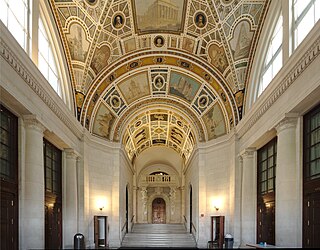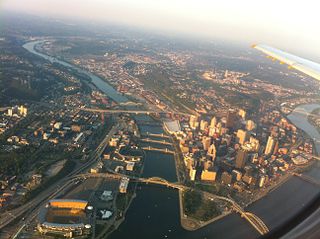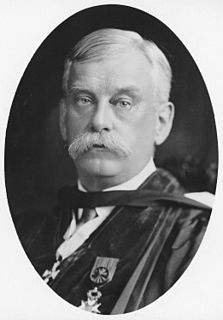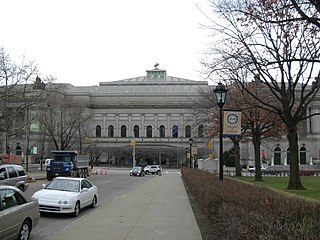
Carnegie is a borough in Allegheny County, Pennsylvania, United States, and is part of the Pittsburgh Metro Area. The population was 7,972 in the 2010 census.

Oakland is the academic and healthcare center of Pittsburgh and one of the city's major cultural centers. The neighborhood is home to three universities, museums, and hospitals, as well as an abundance of shopping, restaurants, and recreational activities. Oakland is home to the Schenley Farms National Historic District which encompasses two city designated historic districts: the mostly residential Schenley Farms Historic District and the predominantly institutional Oakland Civic Center Historic District. It is also home to the locally designated Oakland Square Historic District. The Pittsburgh Bureau of Fire has Fire Station No. 14 on McKee Place and Fire Station No. 10 on Allequippa Street in Oakland.

North Side refers to the region of Pittsburgh, Pennsylvania, located to the north of the Allegheny River and the Ohio River.
The term "North Side" does not refer to a specific neighborhood, but rather to a disparate collection of contiguous neighborhoods.

Schenley Park is a large municipal park located in Pittsburgh, Pennsylvania, between the neighborhoods of Oakland, Greenfield, and Squirrel Hill. It is also listed on the National Register of Historic Places as a historic district. In 2011, the park was named one of "America's Coolest City Parks" by Travel + Leisure.

The Carnegie Library of Pittsburgh is the public library system in Pittsburgh, Pennsylvania. Its main branch is located in the Oakland neighborhood of Pittsburgh, and it has 19 branch locations throughout the city. Like hundreds of other Carnegie libraries, the construction of the main library, which opened in 1895, and several neighborhood branches, was funded by industrialist Andrew Carnegie. The Pittsburgh area holds the distinction of housing the first branches in the United States.

The College of Fine Arts at Carnegie Mellon University in Pittsburgh, in the U.S. state of Pennsylvania oversees the Schools of Architecture, Art, Design, Drama, and Music; along with its associated centers, studios, and galleries.

The Carnegie Science Center is one of the four Carnegie Museums of Pittsburgh, Pennsylvania. It is located in the Chateau neighborhood. It is located across the street from Heinz Field.

Mellon Institute of Industrial Research, founded in 1913 by Andrew W. Mellon and Richard B. Mellon, merged with the Carnegie Institute of Technology in 1967 to form Carnegie Mellon University in Pittsburgh, Pennsylvania, United States. While it ceased to exist as a distinct institution, the landmark building bearing its name remains located at the corner of Fifth Avenue and Bellefield Avenue in Oakland, the city's university district. It is sited adjacent to The Carnegie Mellon Software Engineering Institute (SEI) and the University of Pittsburgh's Bellefield Hall and is across Bellefield Avenue from two other local landmarks: the University of Pittsburgh's Heinz Memorial Chapel and the Cathedral of Learning.

The North Shore is a neighborhood in Pittsburgh, Pennsylvania's North Side. It has a zip code of 15212, and has representation on Pittsburgh City Council by both the council members for District 1 and 6. The neighborhood is home to Heinz Field, PNC Park and The Andy Warhol Museum.

The Greater Pittsburgh Region is a populous region in the United States which is named for its largest city and economic center, Pittsburgh, Pennsylvania. There are several official and unofficial boundary definitions which may be used to describe this region. In the most restrictive definition, the region encompasses Pittsburgh's urban core county, Allegheny, and six nearby Pennsylvania counties.

Rev William Jacob Holland FRSE LLD was the eighth Chancellor of the University of Pittsburgh (1891–1901) and Director of the Carnegie Museums of Pittsburgh. He was an accomplished zoologist and paleontologist, as well as an ordained Presbyterian minister.
The Culture of Pittsburgh stems from the city's long history as a center for cultural philanthropy, as well as its rich ethnic traditions. In the 19th and 20th centuries, wealthy businessmen such as Andrew Carnegie, Henry J. Heinz, Henry Clay Frick, and nonprofit organizations such as the Carnegie Foundation donated millions of dollars to create educational and cultural institutions.

Forbes Avenue is one of the longest streets in Pittsburgh, Pennsylvania, United States. It has a length of about ten miles (16 km) and is named for John Forbes (1707–1759), whose expedition recaptured Fort Duquesne and who renamed the place Pittsburgh in 1758.

Bellefield Boiler Plant, also known as "The Cloud Factory" from its nickname's use in Michael Chabon's 1988 debut novel The Mysteries of Pittsburgh, is a boiler plant located in Junction Hollow between the Carnegie Institute of Pittsburgh and Carnegie Mellon University in the Oakland district of Pittsburgh, Pennsylvania.

The Miller Gallery at Carnegie Mellon University is the art gallery of Carnegie Mellon University in Pittsburgh, Pennsylvania. It is located on the university campus on 5000 Forbes Avenue, at the border between the Oakland and Squirrel Hill neighborhoods.

The Andy Warhol Museum is located on the North Shore of Pittsburgh, Pennsylvania, in the United States. It is the largest museum in North America dedicated to a single artist. The museum holds an extensive permanent collection of art and archives from the Pittsburgh-born pop art icon Andy Warhol.

Dippy is a composite Diplodocus skeleton in Pittsburgh's Carnegie Museum of Natural History, and the holotype of the species Diplodocus carnegii. It is considered the most famous single dinosaur skeleton in the world, due to the numerous plaster casts donated by Andrew Carnegie to several major museums around the world at the beginning of the 20th century.


















